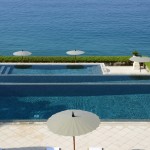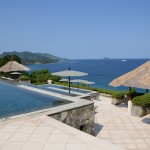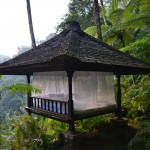Beyond South Bali’s crowded shorelines, life quickly changes heading east.
Frenetic traffic gives way to isolated roads bordered by stacked rice terraces and lush jungle. Scenes of daily village life quickly usurp the fast food and motorcycle calamity. Circumventing the eastern coastline towards the traditional villages of Manggis, Cadidasa, and Tenganan, colossal vines and palm trees vie for space along dramatic cliffsides. Secluded beaches usher in the rising tides from the Straits of Lombok.
Navigating this shoreline feels like a journey back in time. Women stroll along roadsides, balancing buckets of salak (snake fruit) on their heads, and children weave delicate floral arrangements called banten canang as religious offerings for life cycle ceremonies within the village. The colors, the smiles, and the sounds – they’re all so vibrantly expressive. Many of these traditional scenes stem for the Balinese devotion to their own version of Hinduism – Agama Hindu Dharma. This fidelity has resulted in an island of “1000 temples,” none more important than east Bali’s 11th century Mother Temple of Besakih, the inspiration for every temple found in Bali’s countless villages.



Unobtrusively situated in this land of time bygone, east Bali’s most prized resort, the 34-villa Amankila (amanresorts.com) serves as an ambassador and gateway to the island’s coastal stronghold of anthropology and ecology, fostering cross-cultural interactions in near-by villages and facilitating day trips throughout the magnificent countryside. Amankila, or “peaceful hill,” is romanticized utter seclusion at its finest, tranquility in the shadow of the island’s apex, Mount Agung.
The majority of guests at Amankila strive for equilibrium between tropically breezed, unabashed pampering and immersion in Bali’s nature and traditions; and the resort offers the best of both worlds. An early morning sunrise trek to picturesque Gumang Hill or a snorkeling cruise aboard Aman XII is complemented by an afternoon of spa treatments and a beachside private candlelite dinner.
Likewise, a full afternoon of exploring villages, frolicking in renowned water palaces, and bargaining in local markets, often begins with a picnic breakfast on top of the world at either of Amankila’s romantic satellite bales and later ends with a Rijsttafel dinner, a ten course Indonesian dining extravaganza. For those wanting to simply enjoy the understated elegance and outstanding amenities of the resort, opportunities for sheer relaxation are infinite – whether in-suite, beachfront, hilltop, or hillside. Your best memories may well surface as long afternoons, sampling each level of the three-tiered infinity pool or nursing glasses of fine wine at the exclusive beach club amidst a coconut grove.
Next to Amankila, here in the rustic East, you’ll also find Alila Manggis (www.alilahotels.com/manggis) a moderately priced hotel offering exceptional value in a tremendous location. The hotel’s extensive list of activities – from treks to snorkeling trips to visits to uninhabited nearby islands – are experiential and dutifully capture the essence of east Bali.
]]>Read: The Many Sides of Bali Part I: “New Bali”
Found along the island’s east coast and deep in its interior, the area known as “Traditional Bali” captures the island’s timeless spirit, still flourishing in today’s globalized world and unwavering in its cultural foundations. It is here, far removed from the chaos of the modern world, where you’ll lose yourself in the heartfelt hospitality of daily village life, the rewarding treks through rice fields, the burgeoning indigenous arts and craft scene, the odalan ceremonies held at Bali’s “1000 temples” and the pilgrimages to reach them. This is the Bali of fairytales and coffee table books, a land of spiritual awakenings and an invitation to journey to a time bygone.




Coastal brilliance notwithstanding, the country’s rich interior is the pinnacle of the island’s aesthetic and ethnic grandeur. The city of Ubud and its proximate villages showcase the island’s living culture, where eclectic artists interpret the modernization of traditional living, where esteemed Balinese architecture abounds, where village elders trek through the gates of mountaintop luxury hotels to fetch holy water from the temples below, and where the Agung River breathes life into all who grow around her. A seamless amalgamation of alternating levels of dense forest and rice terraces – an unwavering landscape of everlasting vertical and horizontal greens – this is the Bali of legends, the realization of wanderlust and life experience.
Within this sphere of Zen, it is possible to reside either in the heart of the cultural action or on the periphery, engrossed in the natural environment. The centrally located, luxury boutique hotel, Uma Ubud (uma.ubud.como.bz), and the more lavish Amandari (amanresorts.com) lie in the epicenter of Ubud’s prolific arts scene. Both boast the full throttle Eat, Pray, LOVE Ubud experience and are a short drive from renowned yoga centers, cooking schools, and convivial villages where healers, wood carvers, and silversmiths carry on the customs of generations past. A bit further afield, the COMO Shambhala Estate (cse.como.bz) is the evergreen of Ubud inspiration and enlightenment, providing breathtaking backdrops, utter luxury, and outlets for physical stimulation, combining for an end product of unparalleled mental invigoration.
Organized as 3, 5, and 7-day wellness programs, the personal sojourn at COMO Shambhala Estate begins with a consultation from the in-house Aryuvedic doctor, who prepares a bespoke itinerary for time spent at The Estate. Days alternate between spa treatments, hilltop yoga and Pilates classes, jungle treks, and unapologetic relaxation, interspersed by guiltless indulgence in innovative organic meals and revitalizing juices. The suggested structure leaves ample time for a cathartic journey of self, where getting lost around the 23-acre estate and exploring the natural spring pools hugging the mountain’s edge, delighting in the sounds and sights of nature at the riverbank, reflecting on personal achievement, or testing physical fitness at the bonafide “jungle gym” are all options. Accommodations are structured as five luxury “residences” and five “retreat villas,” with the full gamut of haute resort offerings showcased through individualistic motifs like fire, water, and earth. For example, Tejasuara or “Sound of Fire” is a residence where understated design flawlessly tempers the darkness of
the dominant Sumba stone and black bamboo, illuminated by the fire pit that burns beside the sparkling infinity pool.
Indeed, it seems ironic that an island celebrated for its coastal majesty boasts some of its greatest treasures inland. In fact, Bali’s fortunes are everywhere – superbly distributed over its vast volcanoes, lush mountains, and its remote and crowded beaches where timeless villages and show-stopping resorts co-exist in harmony. This multi-faceted island has evolved as a land of diverse escapism, ripe with endless opportunity for adventure, vacation, and self-reflection in the presence of living history and natural wonder.
Next week, Part III: The Rustic East
]]>